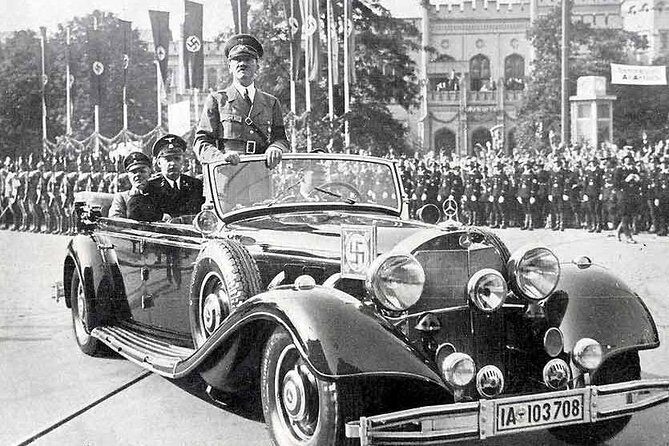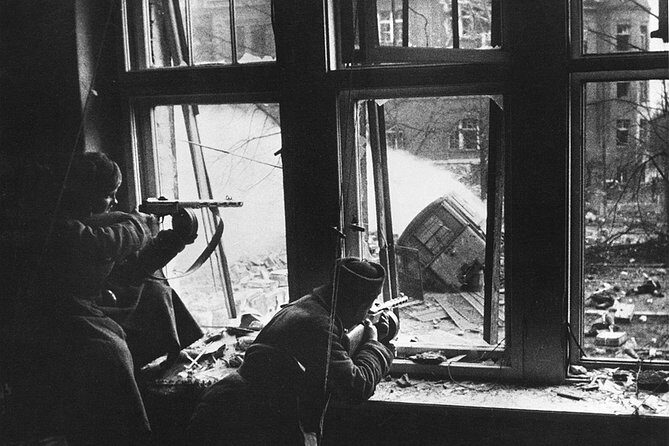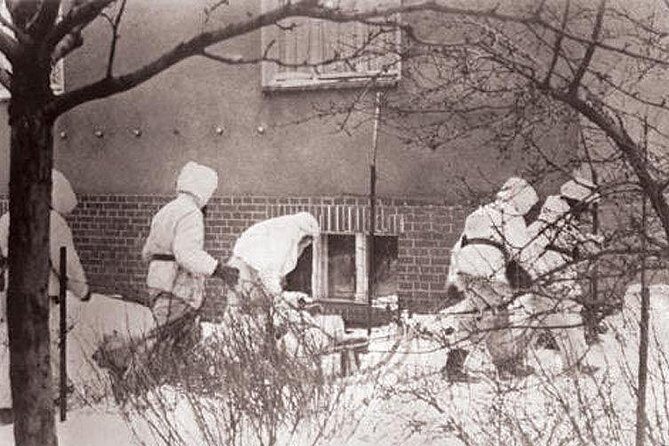Wroclaw’s history is as colorful as its charming streets, and a tour focused on the Nazi era and World War II offers a fascinating look into this city’s resilience. For around $30, you’ll spend roughly two hours exploring key landmarks with a knowledgeable guide, uncovering stories that often go untold in traditional sightseeing. Starting from the Monopol Hotel, the tour winds through Wroclaw’s Old Town, visiting sites like the White Stork Synagogue and the Rynek (Market Square), but what makes this experience stand out are the personal stories and historical insights about Wroclaw’s role during the Nazi period and the siege of the city.
What we love most about this tour is the blend of walking through beautiful historic sites with narratives that reveal wartime experiences—it’s rare to find a tour that combines visual charm with compelling storytelling. The guide, Michal, is praised for being knowledgeable and engaging, which makes the history come alive. Another highlight is the small group size, creating a more personal and interactive experience, allowing plenty of room for questions and discussion.
A potential consideration is the time spent outdoors, which means you’ll want to dress appropriately for the weather, especially since some stops involve walking between locations. Also, because some stops are free and others are not, it’s worth noting that additional tickets may be needed for sites like Wroclaw University or the Parish of the Most Holy Name of Jesus—a small extra expense for more in-depth visits.
This tour suits travelers who are interested in WWII history and Jewish heritage, enjoy walking city tours, or simply want a meaningful way to connect with Wroclaw’s past. If you appreciate stories that go beyond surface level and want to see the city through the lens of its wartime struggles and resilience, this tour is an excellent choice.
Key Points

- Historical Focus: The tour centers on Nazi-era stories and WWII events specific to Wroclaw.
- Well-Paced Walking: Lasts about 2 to 2.5 hours, covering several key historic sites.
- Personal Stories: The guide shares engaging and insightful narratives about wartime life and resistance.
- Accessible and Small Group: Max 20 travelers, offering a more intimate experience.
- Affordable Value: At just over $30, it balances cost with depth of content.
- Additional Sites: Some stops [such as Wroclaw University] have extra admission costs.
A Detailed Look at the Tour Experience

Planning more time in Wroclaw? We've covered other experiences worth considering.
Starting Point and First Impressions
We begin at Hotel Monopol, a historic and elegant building in Wroclaw’s heart. Meeting here is convenient, especially if you’re staying in the city center. The tour kicks off promptly at 1:00 pm, giving you ample time to settle in and prepare for the walk ahead. As we step out with our guide, Michal, the tone is immediately set for an engaging afternoon.
Stops with a Focus on Nazi and WWII History
The Site of the Former Synagogue and Gestapo Building
Our first stop is the site of the New Synagogue, destroyed in 1938, and the nearby Gestapo building. Although the synagogue no longer stands, its history is explained with respect and detail, shedding light on the Jewish community’s presence before the war. Michal shares stories about the Jewish heritage, making this stop both somber and educational. Visitors praised the guide’s ability to blend factual history with personal stories, with Emma_B noting, “Most of this information was new to me, and Michal was excellent at giving a mix of information and answering questions.”
Wolnoci Square and the Nazi Rise
A short walk takes us to Wolnoci Square, where the early days of Nazi Germany are introduced. This site helps you understand how the city’s political landscape shifted and set the stage for the war. It’s a reminder that Wroclaw’s history is deeply intertwined with broader European events.
The White Stork Synagogue and Jewish Heritage
Next, we visit the White Stork Synagogue, which survived the destruction of WWII. It stands as a silent witness to the Jewish community that once thrived here. Michal shares stories about Jewish life during the Holocaust and how this synagogue became a symbol of resilience. Maarten_P said, “He made us attentive to things we would have otherwise missed,” highlighting the guide’s skill in pointing out details that enrich understanding.
City Life Under the Nazi Regime
Wroclaw Market Square and Festung Breslau
Walking into the Rynek, the bustling Market Square, we hear about daily life under Nazi rule and the destruction caused by the siege. The stories woven throughout the square about Festung Breslau—the fortress’s role during the war—bring the scene alive. You’ll see the remnants of wartime damage and hear about the city’s dramatic surrender just four days after Berlin—a fact that surprises many, as the city’s story is often overshadowed by Berlin’s.
Memorials and Educational Sites
Stops include the Dietrich Bonhoeffer Memorial, highlighting German opposition, and the Wroclaw University, where stories about Jewish scientists and educational policies under the Third Reich are discussed. While some sites require extra tickets, they add context about educational changes and resistance efforts. Michal is praised for sharing stories of opposition and resistance, illustrating that even under oppressive regimes, some individuals stood against tyranny.
The Siege of Wroclaw and Final Sites
Market Hall and Wroclaw’s Island
The tour then moves to Hala Targowa (Market Hall), where the siege stories are reinforced, and a short break allows for reflection. The Sand Island and Ostrow Tumski (Cathedral Island) are the final stops, where you’ll learn about Edith Stein, a saint and Holocaust victim, tying personal stories into the broader narrative. The tour concludes on Cathedral Island, offering a tranquil setting that contrasts with the wartime chaos.
Practical Details and Overall Experience
The tour’s cost of $30.06 per person is quite reasonable given the depth of stories and the variety of sites visited. The small group size (up to 20 travelers) ensures a personal experience, and the mobile ticket makes it easy to join without hassle.
While some stops are free, others, like Wroclaw University and the Parish of the Most Holy Name of Jesus, have additional admission fees, which are worth considering if you want to explore those sites more thoroughly. The duration, roughly 2 to 2.5 hours, makes this a manageable afternoon activity, especially for those interested in history, WWII, or Jewish heritage.
What Reviewers Say
The mixed reviews highlight the importance of the guide’s presentation. Emma_B found the tour “really interesting” and appreciated Michal’s skill at sharing a good mix of information. Conversely, Marsha_G felt the guide was disinterested, emphasizing that the experience might depend heavily on the guide’s enthusiasm and depth of knowledge.
Final Thoughts
This tour offers an authentic and human perspective on Wroclaw’s WWII history, blending site visits with storytelling that makes history tangible. It’s perfect for history enthusiasts or those wanting to see the city through a more serious lens. The stories about resistance, destruction, and resilience provide a nuanced view of Wroclaw’s wartime experience, which often gets sidelined in more general tours.
Who Is This Tour Best For?
If you’re a traveler who values knowledgeable guides, enjoys walking through historic sites, and wants a deeper understanding of WWII’s impact on Wroclaw, this tour hits the mark. It’s ideal for those interested in Jewish heritage, resistance stories, or city history. If you prefer light or purely sightseeing tours, this might be a bit intense, but for serious history lovers, it’s a worthwhile journey.
FAQ

Is the tour suitable for all ages?
Most travelers will find this tour appropriate, especially since it involves walking through the city and listening to stories. Children comfortable with history and walking should do well.
Are there any additional costs?
Yes, some sites like Wroclaw University and the Parish of the Most Holy Name of Jesus may require extra admission fees if you want to explore in more detail.
How long does the tour last?
The tour runs approximately 2 to 2.5 hours, making it a manageable activity for most of the afternoon.
Is the tour conducted rain or shine?
Yes. Since it’s primarily walking outdoors, dress appropriately for the weather, and be prepared for potential changes in plans if the weather is poor.
What language is the tour in?
While not explicitly stated, most tours like this are conducted in English, especially given the reviews and booking details.
Can I cancel the tour if my plans change?
Yes, the tour offers free cancellation up to 24 hours in advance for a full refund.
Is the tour suitable for those with limited mobility?
Since the tour involves walking between sites, it’s best suited for those comfortable with moderate walking. Some stops are outdoors and require standing, so consider your mobility needs.
How many people typically join the tour?
The group size is limited to 20 travelers, ensuring a more personal experience and plenty of interaction with the guide.
This guided walk through Wroclaw’s WWII history isn’t just about ticking off sites; it’s about understanding a city that surrendered so soon after Berlin and hearing stories of courage and survival that have shaped its identity. Whether you’re a history buff or simply a curious traveler, this tour offers a valuable perspective that will stay with you long after your visit.
More Tours in Wroclaw
- Oder river cruise and walking tour of Wroclaw
- Wroclaw: City of 100 Bridges 4-Hour Private City Tour
- Wrocaw: Old Town and Ostrów Tumski Walking Tour in English
- Legacy of the World War II Day Tour from Wroclaw
- Wroclaw District Of The Four Temples Private Tour
- Full-Day Private Walking Tour of Krakow from Wroclaw
More Tour Reviews in Wroclaw
- Oder river cruise and walking tour of Wroclaw
- Wrocaw: Boat cruise with a licensed guide (1 hour)
- Private Round Trip to Project Riese Including Tickets
- Wroclaw: City of 100 Bridges 4-Hour Private City Tour
- Wroclaw: Spy-Themed Walk & Game with Host
- Wrocaw: Old Town and Ostrów Tumski Walking Tour in English
More Wroclaw experiences we've covered
- We Rank The 16 Best Walking Tours In Wroclaw
- 16 Top-Rated Wroclaw Tours
- Which Wroclaw Sailing Experiences To Choose? Our Best 3 Picks
- The Top 4 Wroclaw Private Driver Services
- Wroclaw’s 8 Best Historical Tours: Which To Choose?
- Wroclaw’s 3 Best Hiking And Trekking Tours
- Wroclaw’s 7 Best Full-Day Tours: Which To Choose?
- We Rank The 5 Best Food Tours In Wroclaw
- 9 Of The Best Drinking Tours In Wroclaw
- What Are The Best Concert Experiences In Wroclaw? Our Top 3 Picks
- The Top 16 City Tours In Wroclaw
- 16 Of The Best Boat Tours & Cruises In Wroclaw
